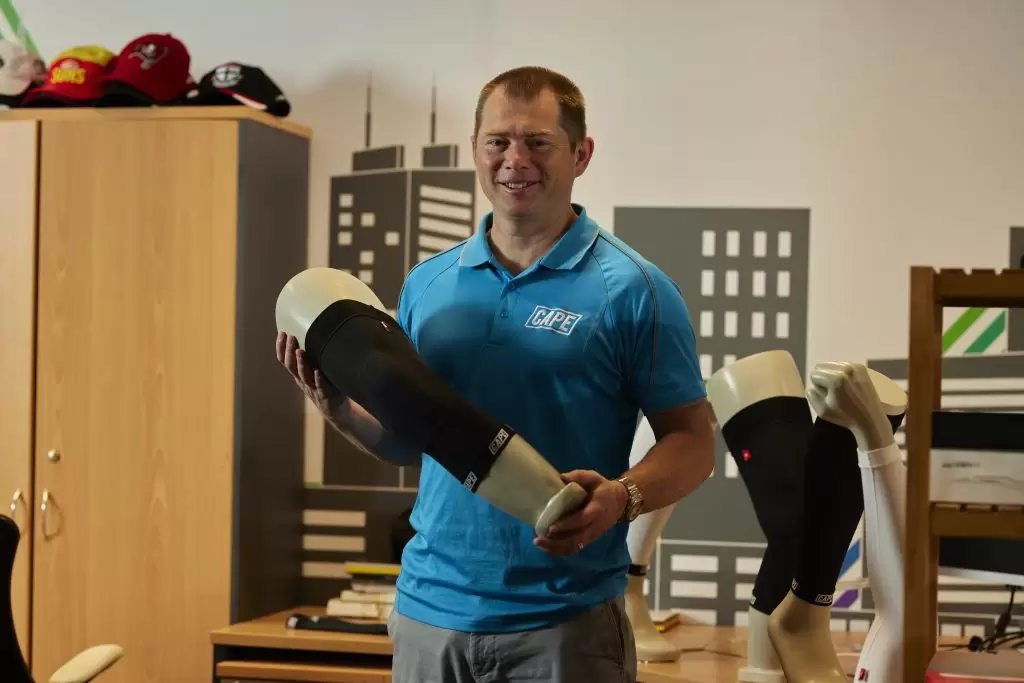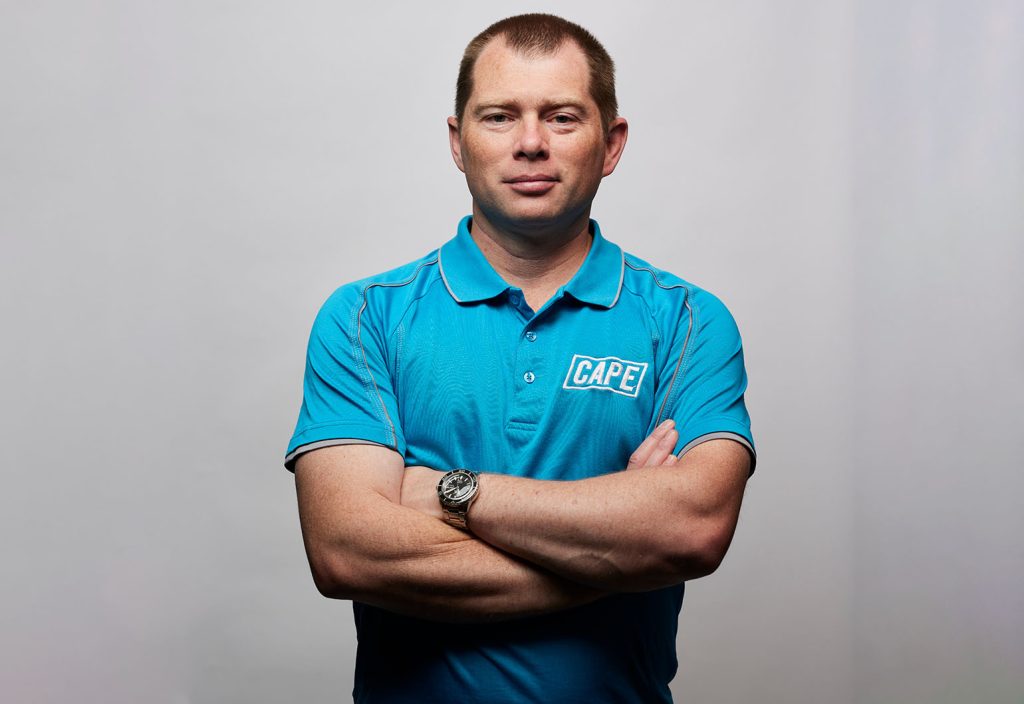Elite athletes have long worn compression garments to enhance performance and aid recovery but, without the benefits of a custom fit, form can outweigh function.
For Dr James Waldie, many of these off-the-shelf garments belong in the category of ‘athleisure’.
“I’d describe a lot of them as tight fashion,” he said. “They might look good, but there’s a question mark over whether they can really improve athlete performance or recovery.”
As CEO and co-founder of medical-grade compression apparel company Cape Bionics, Waldie and his team custom-design and manufacture garments for elite athletes with proprietary compression regimes optimised for performance, recovery, travel or rehabilitation.
The technology is drawn from Waldie’s experience developing compression garments to support astronauts during short and long-term space exploration.
His products, including calf sleeves, leggings and arm sleeves, are now worn by athletes in elite sporting codes across Australia and the US.
“The technology was developed with NASA, MIT and the European Space Agency, so we like to say we make the best compression garments on and off the planet,” said Waldie.
Out of this world
Growing up with a fascination for space and the pioneering spirit of astronauts, Waldie studied aerospace engineering and business administration at Melbourne’s RMIT University, where he explored the impact of microgravity on the human body.
At this time, athletes like Ian Thorpe and Cathy Freeman were racing in their trademark bodysuits at the Sydney Olympic Games. Waldie wondered if he could engineer a similar suit for astronauts that would mimic the normal weight loading experienced on Earth.
Waldie spent almost two decades developing compression spacesuits. While completing his master’s at the University of California in San Diego, he made new findings into the physiological effects of different compression levels.
He then earned a PhD at RMIT and was accepted as a post-doctoral fellow at the Massachusetts Institute of Technology to develop his space skinsuit design with the European Space Agency (ESA).
He also consulted at the NASA Johnson Space Center to help reduce astronaut injury through innovative spacesuits.
So what caused Waldie to shift his focus from space to sport? It all stemmed from a golf-course conversation with his neighbour, James Turner, who is now Managing Director of communications services company Qtec Systems and CEO of specialist VoIP carrier company Coloured Lines.
Waldie had returned to Australia from MIT in 2010 and was working as an aerospace engineer at BAE Systems. Turner said he was fascinated by Waldie’s spacesuit technology and, with a background in entrepreneurship and capital raising, he was curious about its commercial opportunities.
“I could see that this was cutting-edge technology,” said Turner. “We started talking about the occupations that command the elite precision and cutting-edge requirements analogous to that of astronauts, and we centred on medical science and professional sport.”
These are industries where a one-per-cent advantage can make a real difference, he explained.
“People are always striving for an optimum outcome,” said Turner. “We felt that elite sport was the industry most accessible to us as a starting point.”
Waldie spent the next two years developing the technology part-time, while Turner provided some of the seed funding and commercial background.
“Then James quit his job to build Cape full-time and we got our first products out,” said Turner. “Our first meeting was with the Essendon Football Club, and they loved the products. From that point, we were on our way.”
Precision technology
Cape Bionics’ custom compression garments are manufactured in Melbourne from a similar anisotropic material to Waldie’s spacesuits.
The material is stronger in the vertical axis and is circumferentially soft on the body. Unlike the spacesuits, however, they include moisture wicking, an ultraviolet protection factor system, and the elasticity required for sporting applications.
While the traditional production of custom-fit garments includes measuring the body with a tailor’s tape to create a pattern for materials to be sewn together, Cape Bionics uses a 3D scan of an athlete’s body. Its patented AutoTailor system then analyses the scan and designs the garment to match an athlete’s precise measurements and the selected compression regime.
“We have the capability to take thousands of measurements from the scan, rather than just a few with a tailor’s tape,” said Waldie.
“We design the garment for each one millimetre of length for the material properties and for the desired compression regime.”
Waldie adds that his technology eliminates the guesswork of traditional measurement methods.
“With a tailor’s tape, you might take an ankle measurement and a maximum calf measurement, for instance, but what happens in between? With our system, we are designing for each point of the limb, and that’s really critical, because a lot of the compression regimes are graduated.”
Compression power
The key benefit of compression is the augmentation of blood and lymphatic flow. Cape Bionics’ research shows different compression regimes are optimal for different scenarios.
When AFL players are recovering from a game, for instance, their body is in a semi-relaxed state and their heart rate is normal.
Cape’s research shows that a higher level of compression can maximise blood flow and the removal of waste by-products from recent exercise, while reducing muscle soreness, damage or swelling.
In contrast, when a player is on the field, their aerobic demand is high, and a custom compression garment designed for performance can reduce the likelihood of delayed-onset muscle soreness and increase endurance and strength.
“We’re slightly manipulating the vascular system for different scenarios,” said Waldie.
“We’re also looking at tailored support for post-surgical procedures such as ACLs.”
Jessica Stephens, a sports scientist at the ACT Academy of Sport, has a special interest in recovery modalities. While working as a PhD student at the Australian Institute of Sport, she and her colleagues compared the compression profile of off-the-shelf compression garments and how it changed with body posture.
“We looked at the compression profile of a recommended-size garment, plus a garment either below or above the recommended size,” she explained.
“We found that the recommended-size garment didn’t always have the most optimal pressure profile for a particular athlete, if you’re looking at what a compression garment is meant to do, which is to provide sequential compression based from the extremities back into the centre of the body.”
Put to the test
Cape Bionics recently launched a PhD program with the Queensland University of Technology and Queensland Academy of Sport to investigate the benefits of its garments on elite athletes.
The company has also performed ultrasound readings to examine increased blood flow generated by its garments, as well as reduced muscle oscillation for injury recovery.

“Almost all of our garments are used for recovery,” said Waldie.
“Initially, we assumed that athletes would wear these garments during the games, because that’s where I thought you would wish to have peak performance. But, in order to have the highest performance over a season, you need to have very strong recovery protocols.”
Ian McKeown is Director of McKeown Performance and an advisor to Cape Bionics. He completed his PhD in strength and conditioning at the Australian Institute of Sport and became aware of Cape Bionics’ products while working as the Head of High Performance at Port Adelaide Football Club.
“The logic behind what Cape Bionics was doing just made so much sense to me,” he said.
“While I was working with Port Adelaide, I’d have to try to work out what size compression garment each player needed for recovery, and if I wasn’t guessing, they were guessing.
“We place so much importance on recovery after a game and there is a lot of rigour behind the protocols, but it’s a house of cards if you’re basing it on something that doesn’t fit correctly and that isn’t fit for purpose. You can upgrade your recovery protocols exponentially when it’s not down to chance.”
McKeown added that the custom-made nature of Cape Bionics garments can also have a powerful effect on athletes.
“There’s a belief effect in recovery science,” he said.
“If an athlete gets a computer scan of their body to create a recovery garment that’s fitted perfectly to them, that special attention can improve the efficacy of the recovery protocols.”
Future fit
Cape Bionics employs a team of 12 people in Melbourne and has recently expanded its operations to the US. While its current scanning technology generally scans athletes in their training rooms, the company is developing an iPhone solution that will allow athletes to scan themselves.
“That’s when the business can really scale, because we can start to support huge numbers of athletes,” said Waldie.
“Whether they’re scanned by us or self-scanned by a team member, or scanned by themselves at home using their phone, AutoTailor can ingest it and produce the pattern.”
Cape Bionics currently works with sporting codes including football, baseball, basketball and soccer in Australia and the US.
It is also exploring opportunities in the medical field with compression garments to treat conditions such as lymphedema and lipedema. Its products may also be suitable for the treatment of burns, as its scanning technology eliminates the need to touch the body in order to measure it.
“There are also pilots trialling calf sleeves from our travel compression regime, and they’re finding significant benefits over traditional compression socks,” said Waldie.
“There are many potential applications, but we need to be strategic in how we apply the technology, and we need to grow the business on a solid foundation.”
